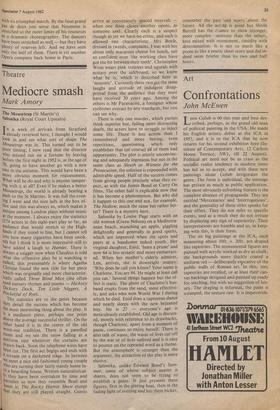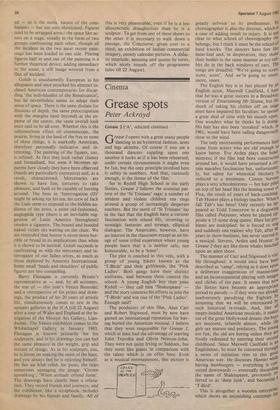Art
Confrontations
John McEwen
Leon Golub is 60 this year and best des- cribed, perhaps, as the grand old man of political painting in the USA. He made his English artistic debut at the ICA in 1957, and it is to the ICA that he now returns for his second exhibition here (In- stitute of Contemporary Arts, 12 Carlton House Terrace, SW1, till 22 August). Political art need not be as crass as the socialist realist tendency in modern times has led us to accept, and with these new paintings alone Golub invigorates the genre. The form is individual, the message has private as much as public application. The most obviously refreshing feature is the complete absence of propaganda. They are entitled 'Mercenaries' and 'Interrogations', and the generality of those titles speaks for their effect. They do not refer to specific events, and as a result they do not irritate by displaying any sign of superiority. Their interpretations are humble and so, in keep- ing with this, is their form.
The six big paintings at the ICA, each measuring about 10ft x 20ft, are draped like tapestries. The monumental figures are painted with acrylic worked as dry as chalk, the backgrounds more thickly coated a uniform red — deliberately evocative of the public walls of Roman art. In this, too, tapestries are recalled, or at least their' can- vas backings designed and painted up ready for stitching, but with no suggestion of lux- ury. The draping is informal, the paint is scrimped, the texture raw. It is impoverish- ed — as is the mora nature of the com- batants — but not unsir nhisticated. Figures tend to be arranged acra, -; the space like ac- tors on a stage, usually in the form of two groups confronting each other, though all the incident in the two most recent pain- tings has been loaded to one side. Placing figures half in and out of the painting is a further theatrical device, adding immediacy to the scene, a still image wrested from a flux of incident.
Golub is unashamedly European in his allegiance and once attacked his abstract in- clined American contemporaries for discar- ding 'the individualist of the Renaissance', but he nevertheless seems to adopt their sense of space. There is the same disdain for illusions of depth, the same preoccupation with the margins (and beyond) at the ex- pense of the centre, the same overall look once said to be all over. Whether this is the subconscious effect of cinemascope, the prairie, living in the land of the free or none of these things, it is markedly American, therefore personally indicative and in- teresting. The painting of the figures, too, is refined. At first they look rather clumsy and formalised, but soon it becomes ap- parent how closely.they have been observed (hands are particularly expressive) and, as a result, characterised. Mercenaries are shown to have fun, torturers to take pleasure, and both to be capable of horsing around. The boss in 'Interrogation (II)' might be asking for his tea, his crew of Jack the Lads seem to respond to the hidden au- dience of the artist, a more old-fashioned, anglophile type (there is an inevitable sug- gestion of Latin America throughout) smokes a cigarette. The bound and hooded naked victim sits waiting on the chair. We are reminded that horror is never more hor- rible or broad in its implications than when it is shown to be normal. Golub succeeds in confronting us with the mercenary and in- terrogator of our fallen selves, as much as those deplored by Amnesty International. Some small 'heads and shoulders' of public figures are less compelling.
Barry Flanagan is currently Britain's representative at — and, by all accounts, the star of — this year's Venice Biennale; and a retrospective of his prints and draw- ings, the product of his 20 years of artistic life, simultaneously comes to rest in the upstairs galleries at the ICA (till 22 August) after a tour of Wales and England at the in- stigation of the Mostyn Art Gallery, Llan- dudno. The Venice exhibition comes to the Whitechapel Gallery in January 1983. Flanagan is known primarily for his sculptures, and in his drawings you can feel the same pleasure in the weight, grip and texture of things. As in his sculpture, too, he is intent on making the most of the least, and you always feel he is enjoying himself. He has an Irish relish for puns, the titles sometimes upstaging the image: 'Grown upstalking'; 'When attitude offend form'. The drawings have clearly been a relaxa- tion. They record friends and journeys, and the exhibition, like a scrapbook, includes drawings by his friends and family. All of this is very pleasurable, even if he is a less idiosyncratic draughtsman than he is a sculptor. To get from one of these shows to the other it is necessary to walk down a passage, the Concourse, given over to a third, an exhibition of Indian commercial imagery, mostly calendar pictures. A didac- tic interlude, amusing and quaint by turns, which nicely rounds off the programme (also till 22 August).



































 Previous page
Previous page